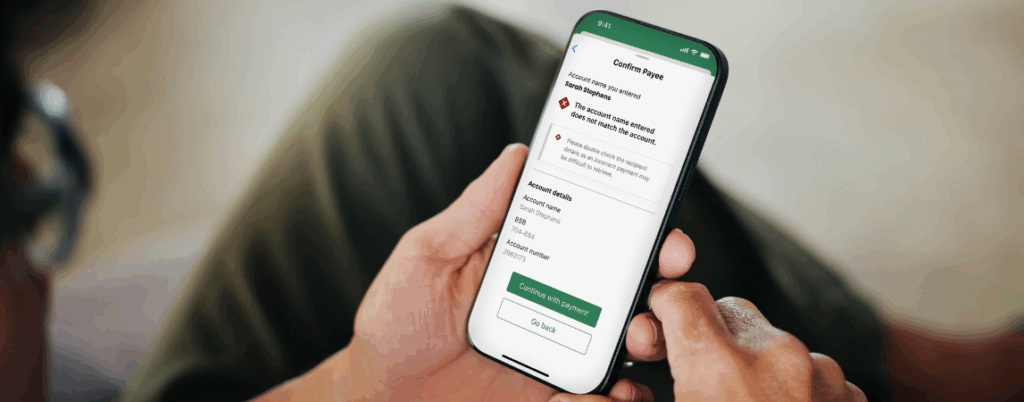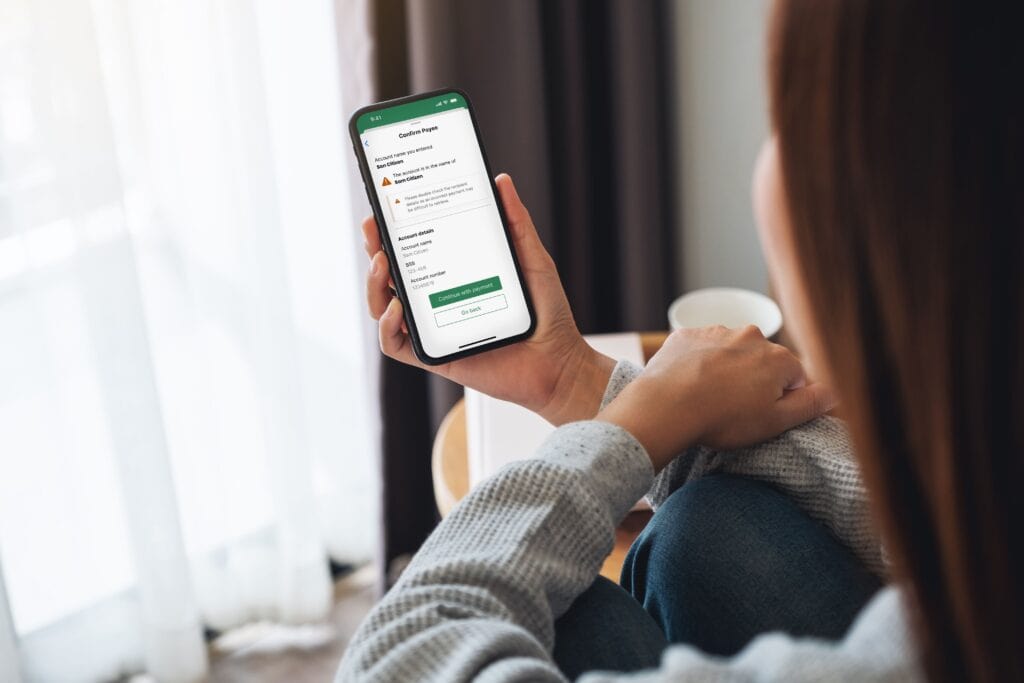Australian banks unveiled their latest scam fighting technology, with the launch of Confirmation of Payee – a new name-matching service designed to help protect customers from being tricked into sending money to criminals.

What is Confirmation of Payee?
Confirmation of Payee (CoP) is an industry-wide service that checks the name of the person or business you intend to pay against the account details you enter. Before a transfer is made, you’ll be notified if the name on the receiving account doesn’t match, helping reduce scams and mistaken payments.
From July 2025, banks across Australia will begin rolling out Confirmation of Payee. This added layer of security gives customers greater confidence when sending money.

How it works
When you make a payment, you may be asked to provide.
- The account name
- The BSB
- The account number
Your bank will then check these details and return a message confirming whether the name matches:

✅ Match – The name and details match
⚠️ Close match – The name is similar, but not exact
❌ No match – The name doesn’t match the account
You’ll be able to review this information before deciding whether to proceed.
When will it be available?
Confirmation of Payee will begin rolling out from July 2025, with banks progressively introducing the service across Australia. A national education campaign will support this rollout, helping Australians understand what to expect and how to use the new service.
Banks have launched a new weapon in the fight against scammers
Watch how banks are using cutting-edge technology to help protect customers from being tricked into sending money to criminals. This campaign was developed in partnership with Customer Owned Banking Association and Australian Payments Plus.
FAQs
When you key in a BSB, account number and the payee’s name for the first time (or when you edit an existing payee), your bank sends those details to a central matching service run for the industry by Australian Payments Plus. The recipient bank checks whether the name on its books matches the name you entered and returns a “match”, “close match” or “no match” result in real time; a simple traffic-light message then appears on your screen so you can decide whether to proceed, double-check or cancel before any money leaves your account.
You don’t need to do anything, Confirmation of Payee will appear automatically in your banking app or online banking when it becomes available.
Banks committed to rolling out this technology throughout 2025 and we’re delivering on this commitment. Implementing an industry-wide confirmation of payee system required a significant build and investment. Australia is only one of a handful of countries to have this anti-scam technology available across the industry.
With 15.4 billion transactions worth $2.5 trillion occurring every year across the banking sector, the design and build of an industry wide confirmation of payee system is a major undertaking. It’s further demonstration that Australian banks are leading the way when it comes to safeguarding their customers.
It cost $100 million to design and build the national Confirmation of Payee platform. All that funding comes from Australia’s banks – major, regional and customer-owned – which voluntarily pooled the money under the industry’s Scam-Safe Accord well before any regulatory mandate. No taxpayer or government funds were used; the sector stepped up on its own to deliver this extra layer of protection for customers.
Implementation of the Scam-Safe Accord is well progressed. Initiatives related to biometric checks, limiting payments to high-risk crypto platforms, enhanced intelligence sharing and the development of anti-scam strategies are all complete. Banks are now rolling-out confirmation of payee and introducing warnings and delays.
Think of PayID as the “easy-to-remember nickname” for an account: you type in a mobile number or email address, your bank shows you the name on file, and off the money goes. That works brilliantly when the person you’re paying has set up a PayID, but plenty haven’t. Picture paying a plumber who just texts you a BSB and account number on the spot or settling an invoice from a small tradie who prints those details on the bill. In those moments, Confirmation of Payee becomes the star player: it lets you know instantly whether you’re sending money to the right person. In short, PayID makes paying simpler; CoP makes traditional payments safer, giving Australians an extra line of defence against mis-directed transfers and invoice-redirection scams.
Customers of CommBank, NAB, ANZ, Westpac, HSBC and Macquarie will start to see the new “match / close-match / no-match” prompt roll out progressively from July. Other banks will start to roll out the service over the coming months, and Australian Payments Plus has set a target of “near-universal coverage” (over 95 % of personal accounts) by December 2025.
Only the BSB, account number and the name you type are sent to the industry hub run by AP+. The recipient bank compares those details to its own records and sends back a simple “match / close match / no match” code. If there is no match, the payee’s name is not revealed, and all underlying account data stays inside each bank; there is no central database. Traffic between banks is encrypted and every request is digitally signed, so nothing new is exposed beyond the yes-or-no result.
Yes. CoP is an advisory checkpoint, not a hard block. After a “close match” or “no match” alert you may correct the details or choose to continue. If you press ahead and the money ends up in the wrong hands, liability falls under the existing ePayments Code: banks reimburse errors caused by their systems, but authorising a transfer to the wrong account is usually at the customer’s risk. That makes the CoP warning a critical last line of defence.
The matching algorithm allows for ordinary typos but not wholesale name changes, and the recipient’s name is shown only when there is at least a close match; a “no match” response simply withholds the name, depriving criminals of useful clues.
At launch, Confirmation of Payee is a domestic-only safeguard. It works on any Australian payment that uses a BSB and account number. AP+’s priority is to finish the national roll-out before exploring cross-border options. Until then, customers sending money overseas should keep using their normal checks and controls.
Early adopters include the UK (2020), the Netherlands (2017) and Belgium (2022), as well as New Zealand (2024). Today, Australia joins this first handful of countries in launching a nation-wide name-checking safeguard funded entirely by its banks. Countries such as India, Canada, Singapore, Hong Kong and South Africa are currently following Australia in building or piloting similar tools.
